Job Satisfaction: Generational Differences in the Workplace
VerifiedAdded on 2021/05/27
|7
|1789
|34
Essay
AI Summary
This essay delves into the critical factors influencing job satisfaction within organizations, emphasizing the impact of generational differences. It examines the role of financial benefits, working environments, and internal communication in shaping employee satisfaction. The essay highlights how younger and older employees may have differing expectations and priorities, particularly regarding pay structures, workplace dynamics, and communication styles. The author synthesizes findings from various research papers, identifying limitations such as a narrow focus on specific factors and a lack of comprehensive analysis of generational impacts. The conclusion underscores the importance for management to recognize and address these generational differences to enhance overall employee satisfaction and organizational effectiveness.
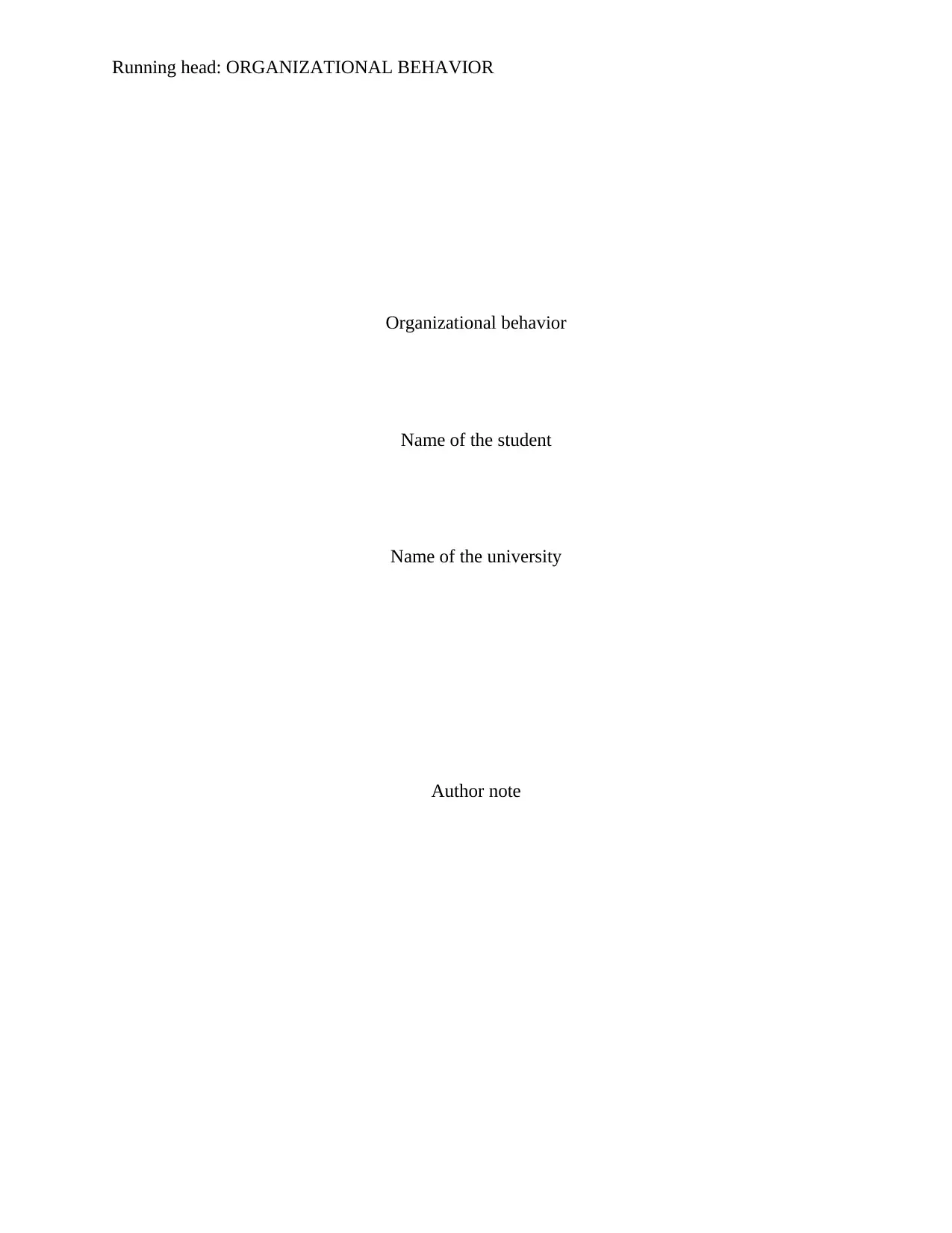
Running head: ORGANIZATIONAL BEHAVIOR
Organizational behavior
Name of the student
Name of the university
Author note
Organizational behavior
Name of the student
Name of the university
Author note
Paraphrase This Document
Need a fresh take? Get an instant paraphrase of this document with our AI Paraphraser
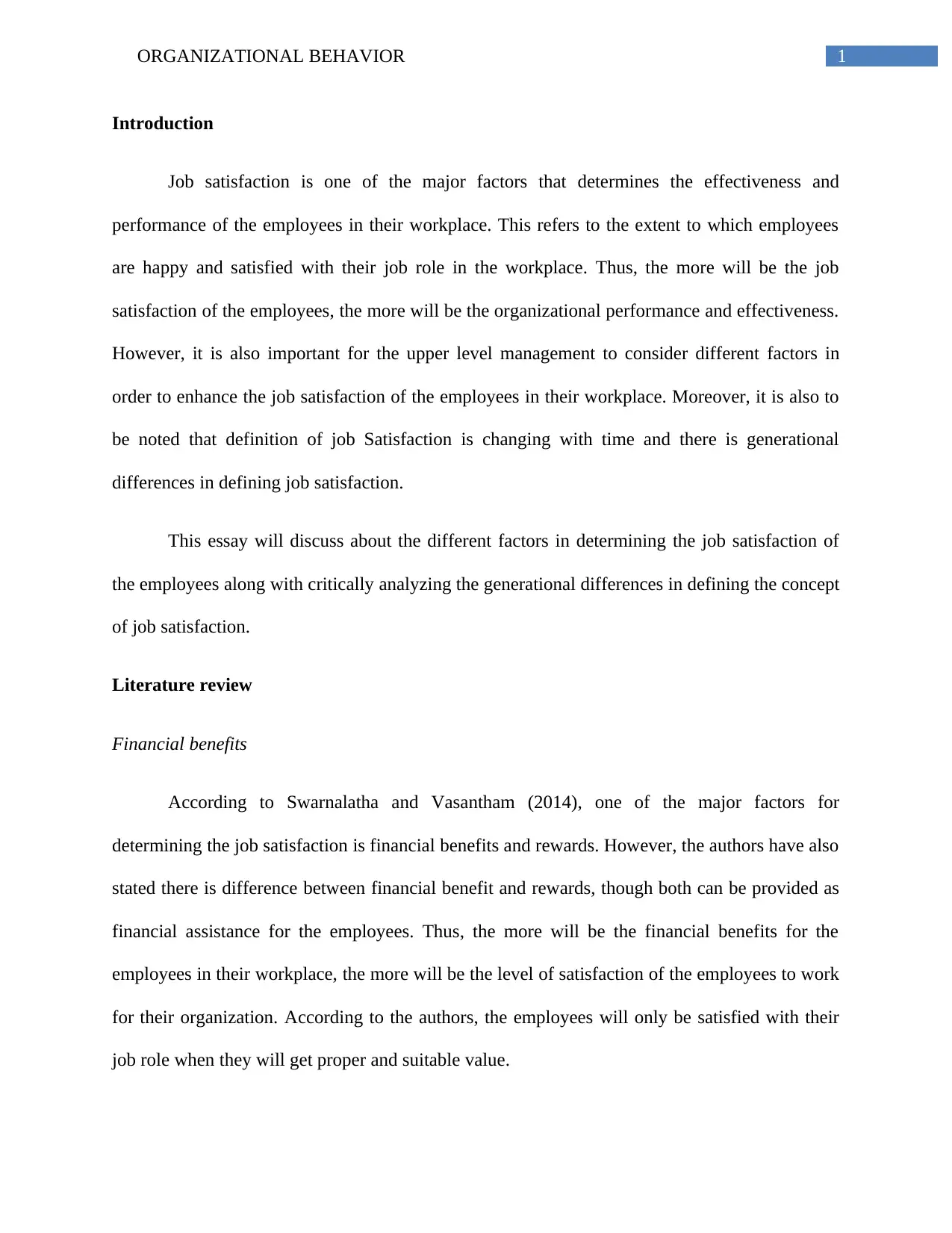
1ORGANIZATIONAL BEHAVIOR
Introduction
Job satisfaction is one of the major factors that determines the effectiveness and
performance of the employees in their workplace. This refers to the extent to which employees
are happy and satisfied with their job role in the workplace. Thus, the more will be the job
satisfaction of the employees, the more will be the organizational performance and effectiveness.
However, it is also important for the upper level management to consider different factors in
order to enhance the job satisfaction of the employees in their workplace. Moreover, it is also to
be noted that definition of job Satisfaction is changing with time and there is generational
differences in defining job satisfaction.
This essay will discuss about the different factors in determining the job satisfaction of
the employees along with critically analyzing the generational differences in defining the concept
of job satisfaction.
Literature review
Financial benefits
According to Swarnalatha and Vasantham (2014), one of the major factors for
determining the job satisfaction is financial benefits and rewards. However, the authors have also
stated there is difference between financial benefit and rewards, though both can be provided as
financial assistance for the employees. Thus, the more will be the financial benefits for the
employees in their workplace, the more will be the level of satisfaction of the employees to work
for their organization. According to the authors, the employees will only be satisfied with their
job role when they will get proper and suitable value.
Introduction
Job satisfaction is one of the major factors that determines the effectiveness and
performance of the employees in their workplace. This refers to the extent to which employees
are happy and satisfied with their job role in the workplace. Thus, the more will be the job
satisfaction of the employees, the more will be the organizational performance and effectiveness.
However, it is also important for the upper level management to consider different factors in
order to enhance the job satisfaction of the employees in their workplace. Moreover, it is also to
be noted that definition of job Satisfaction is changing with time and there is generational
differences in defining job satisfaction.
This essay will discuss about the different factors in determining the job satisfaction of
the employees along with critically analyzing the generational differences in defining the concept
of job satisfaction.
Literature review
Financial benefits
According to Swarnalatha and Vasantham (2014), one of the major factors for
determining the job satisfaction is financial benefits and rewards. However, the authors have also
stated there is difference between financial benefit and rewards, though both can be provided as
financial assistance for the employees. Thus, the more will be the financial benefits for the
employees in their workplace, the more will be the level of satisfaction of the employees to work
for their organization. According to the authors, the employees will only be satisfied with their
job role when they will get proper and suitable value.
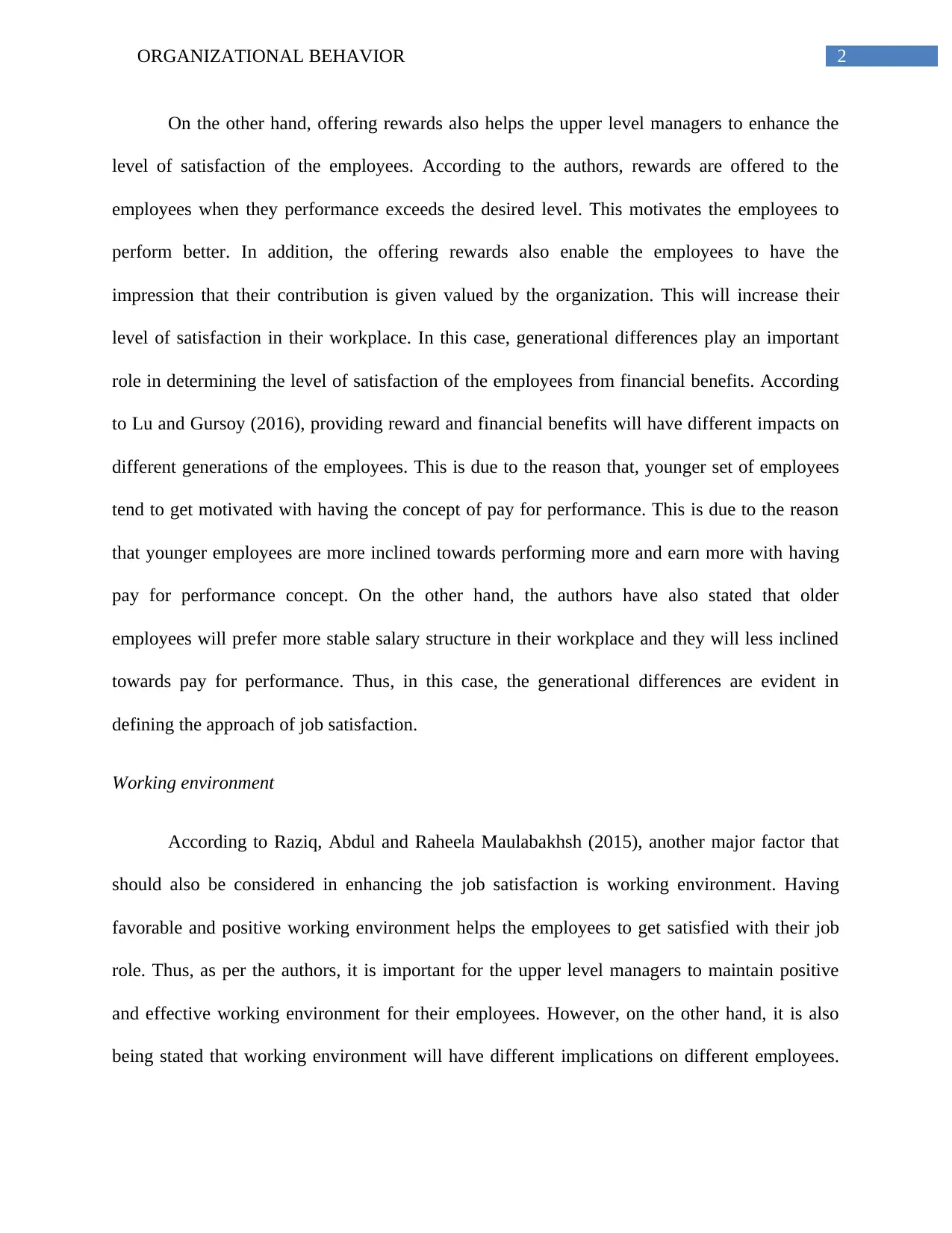
2ORGANIZATIONAL BEHAVIOR
On the other hand, offering rewards also helps the upper level managers to enhance the
level of satisfaction of the employees. According to the authors, rewards are offered to the
employees when they performance exceeds the desired level. This motivates the employees to
perform better. In addition, the offering rewards also enable the employees to have the
impression that their contribution is given valued by the organization. This will increase their
level of satisfaction in their workplace. In this case, generational differences play an important
role in determining the level of satisfaction of the employees from financial benefits. According
to Lu and Gursoy (2016), providing reward and financial benefits will have different impacts on
different generations of the employees. This is due to the reason that, younger set of employees
tend to get motivated with having the concept of pay for performance. This is due to the reason
that younger employees are more inclined towards performing more and earn more with having
pay for performance concept. On the other hand, the authors have also stated that older
employees will prefer more stable salary structure in their workplace and they will less inclined
towards pay for performance. Thus, in this case, the generational differences are evident in
defining the approach of job satisfaction.
Working environment
According to Raziq, Abdul and Raheela Maulabakhsh (2015), another major factor that
should also be considered in enhancing the job satisfaction is working environment. Having
favorable and positive working environment helps the employees to get satisfied with their job
role. Thus, as per the authors, it is important for the upper level managers to maintain positive
and effective working environment for their employees. However, on the other hand, it is also
being stated that working environment will have different implications on different employees.
On the other hand, offering rewards also helps the upper level managers to enhance the
level of satisfaction of the employees. According to the authors, rewards are offered to the
employees when they performance exceeds the desired level. This motivates the employees to
perform better. In addition, the offering rewards also enable the employees to have the
impression that their contribution is given valued by the organization. This will increase their
level of satisfaction in their workplace. In this case, generational differences play an important
role in determining the level of satisfaction of the employees from financial benefits. According
to Lu and Gursoy (2016), providing reward and financial benefits will have different impacts on
different generations of the employees. This is due to the reason that, younger set of employees
tend to get motivated with having the concept of pay for performance. This is due to the reason
that younger employees are more inclined towards performing more and earn more with having
pay for performance concept. On the other hand, the authors have also stated that older
employees will prefer more stable salary structure in their workplace and they will less inclined
towards pay for performance. Thus, in this case, the generational differences are evident in
defining the approach of job satisfaction.
Working environment
According to Raziq, Abdul and Raheela Maulabakhsh (2015), another major factor that
should also be considered in enhancing the job satisfaction is working environment. Having
favorable and positive working environment helps the employees to get satisfied with their job
role. Thus, as per the authors, it is important for the upper level managers to maintain positive
and effective working environment for their employees. However, on the other hand, it is also
being stated that working environment will have different implications on different employees.
⊘ This is a preview!⊘
Do you want full access?
Subscribe today to unlock all pages.

Trusted by 1+ million students worldwide
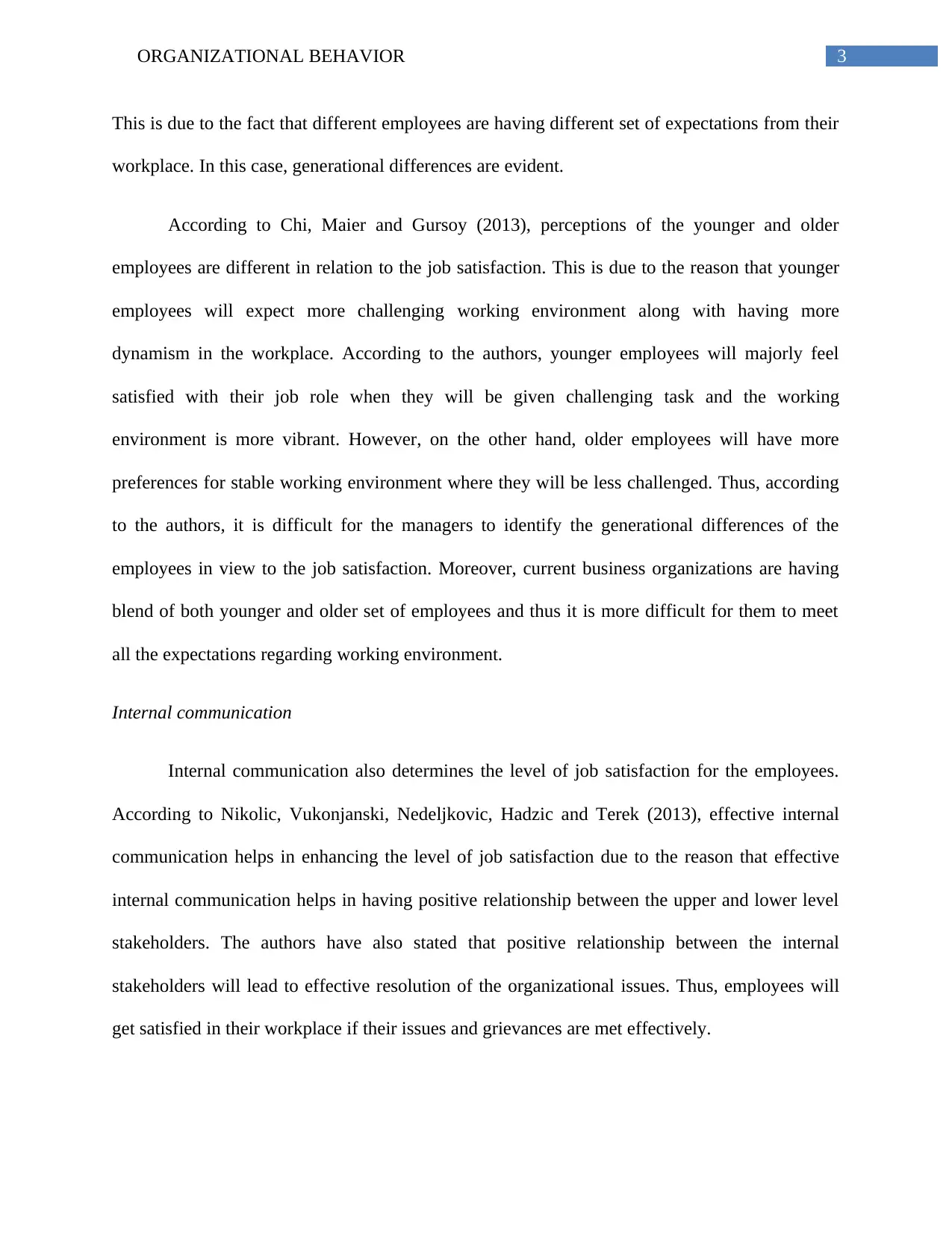
3ORGANIZATIONAL BEHAVIOR
This is due to the fact that different employees are having different set of expectations from their
workplace. In this case, generational differences are evident.
According to Chi, Maier and Gursoy (2013), perceptions of the younger and older
employees are different in relation to the job satisfaction. This is due to the reason that younger
employees will expect more challenging working environment along with having more
dynamism in the workplace. According to the authors, younger employees will majorly feel
satisfied with their job role when they will be given challenging task and the working
environment is more vibrant. However, on the other hand, older employees will have more
preferences for stable working environment where they will be less challenged. Thus, according
to the authors, it is difficult for the managers to identify the generational differences of the
employees in view to the job satisfaction. Moreover, current business organizations are having
blend of both younger and older set of employees and thus it is more difficult for them to meet
all the expectations regarding working environment.
Internal communication
Internal communication also determines the level of job satisfaction for the employees.
According to Nikolic, Vukonjanski, Nedeljkovic, Hadzic and Terek (2013), effective internal
communication helps in enhancing the level of job satisfaction due to the reason that effective
internal communication helps in having positive relationship between the upper and lower level
stakeholders. The authors have also stated that positive relationship between the internal
stakeholders will lead to effective resolution of the organizational issues. Thus, employees will
get satisfied in their workplace if their issues and grievances are met effectively.
This is due to the fact that different employees are having different set of expectations from their
workplace. In this case, generational differences are evident.
According to Chi, Maier and Gursoy (2013), perceptions of the younger and older
employees are different in relation to the job satisfaction. This is due to the reason that younger
employees will expect more challenging working environment along with having more
dynamism in the workplace. According to the authors, younger employees will majorly feel
satisfied with their job role when they will be given challenging task and the working
environment is more vibrant. However, on the other hand, older employees will have more
preferences for stable working environment where they will be less challenged. Thus, according
to the authors, it is difficult for the managers to identify the generational differences of the
employees in view to the job satisfaction. Moreover, current business organizations are having
blend of both younger and older set of employees and thus it is more difficult for them to meet
all the expectations regarding working environment.
Internal communication
Internal communication also determines the level of job satisfaction for the employees.
According to Nikolic, Vukonjanski, Nedeljkovic, Hadzic and Terek (2013), effective internal
communication helps in enhancing the level of job satisfaction due to the reason that effective
internal communication helps in having positive relationship between the upper and lower level
stakeholders. The authors have also stated that positive relationship between the internal
stakeholders will lead to effective resolution of the organizational issues. Thus, employees will
get satisfied in their workplace if their issues and grievances are met effectively.
Paraphrase This Document
Need a fresh take? Get an instant paraphrase of this document with our AI Paraphraser
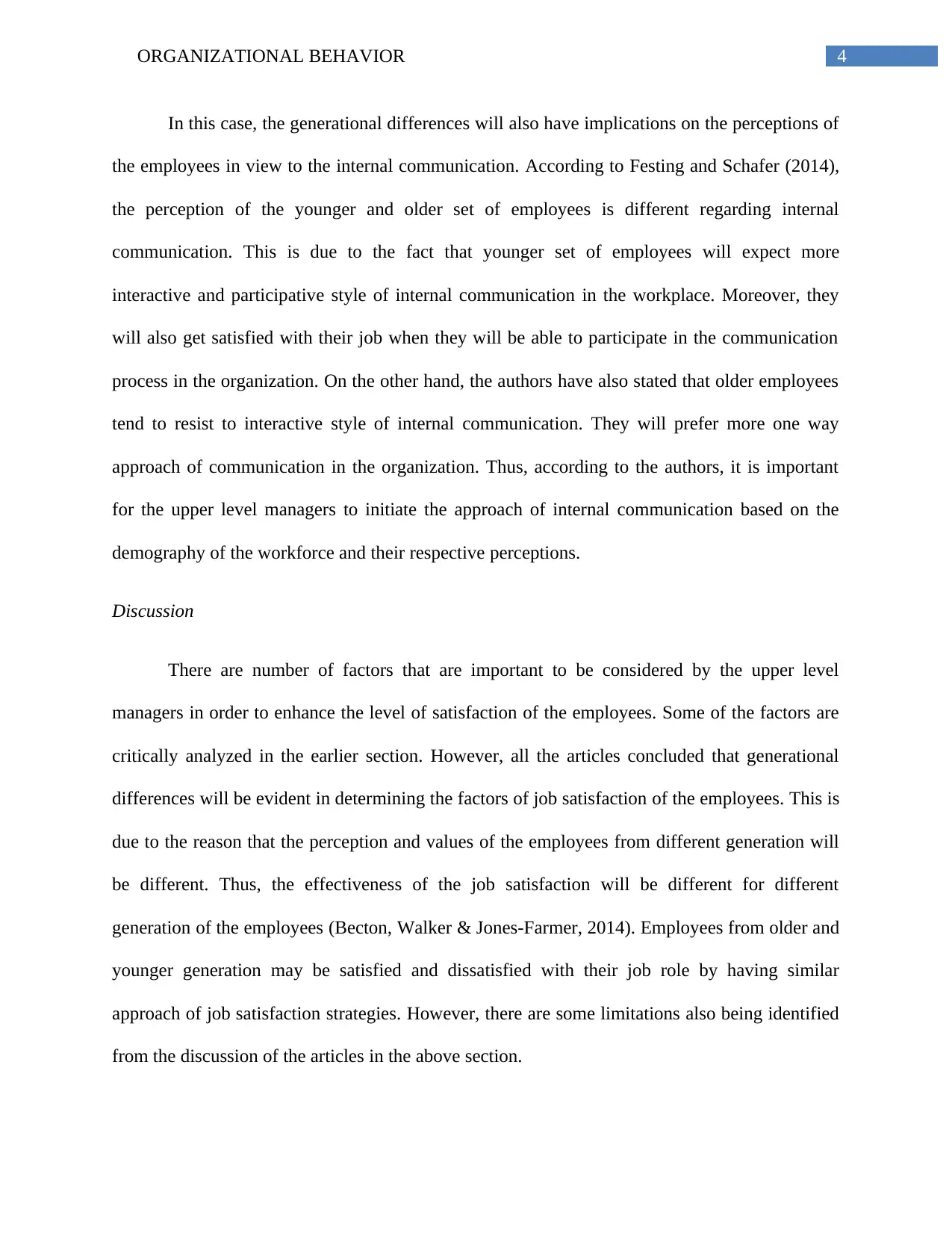
4ORGANIZATIONAL BEHAVIOR
In this case, the generational differences will also have implications on the perceptions of
the employees in view to the internal communication. According to Festing and Schafer (2014),
the perception of the younger and older set of employees is different regarding internal
communication. This is due to the fact that younger set of employees will expect more
interactive and participative style of internal communication in the workplace. Moreover, they
will also get satisfied with their job when they will be able to participate in the communication
process in the organization. On the other hand, the authors have also stated that older employees
tend to resist to interactive style of internal communication. They will prefer more one way
approach of communication in the organization. Thus, according to the authors, it is important
for the upper level managers to initiate the approach of internal communication based on the
demography of the workforce and their respective perceptions.
Discussion
There are number of factors that are important to be considered by the upper level
managers in order to enhance the level of satisfaction of the employees. Some of the factors are
critically analyzed in the earlier section. However, all the articles concluded that generational
differences will be evident in determining the factors of job satisfaction of the employees. This is
due to the reason that the perception and values of the employees from different generation will
be different. Thus, the effectiveness of the job satisfaction will be different for different
generation of the employees (Becton, Walker & Jones-Farmer, 2014). Employees from older and
younger generation may be satisfied and dissatisfied with their job role by having similar
approach of job satisfaction strategies. However, there are some limitations also being identified
from the discussion of the articles in the above section.
In this case, the generational differences will also have implications on the perceptions of
the employees in view to the internal communication. According to Festing and Schafer (2014),
the perception of the younger and older set of employees is different regarding internal
communication. This is due to the fact that younger set of employees will expect more
interactive and participative style of internal communication in the workplace. Moreover, they
will also get satisfied with their job when they will be able to participate in the communication
process in the organization. On the other hand, the authors have also stated that older employees
tend to resist to interactive style of internal communication. They will prefer more one way
approach of communication in the organization. Thus, according to the authors, it is important
for the upper level managers to initiate the approach of internal communication based on the
demography of the workforce and their respective perceptions.
Discussion
There are number of factors that are important to be considered by the upper level
managers in order to enhance the level of satisfaction of the employees. Some of the factors are
critically analyzed in the earlier section. However, all the articles concluded that generational
differences will be evident in determining the factors of job satisfaction of the employees. This is
due to the reason that the perception and values of the employees from different generation will
be different. Thus, the effectiveness of the job satisfaction will be different for different
generation of the employees (Becton, Walker & Jones-Farmer, 2014). Employees from older and
younger generation may be satisfied and dissatisfied with their job role by having similar
approach of job satisfaction strategies. However, there are some limitations also being identified
from the discussion of the articles in the above section.
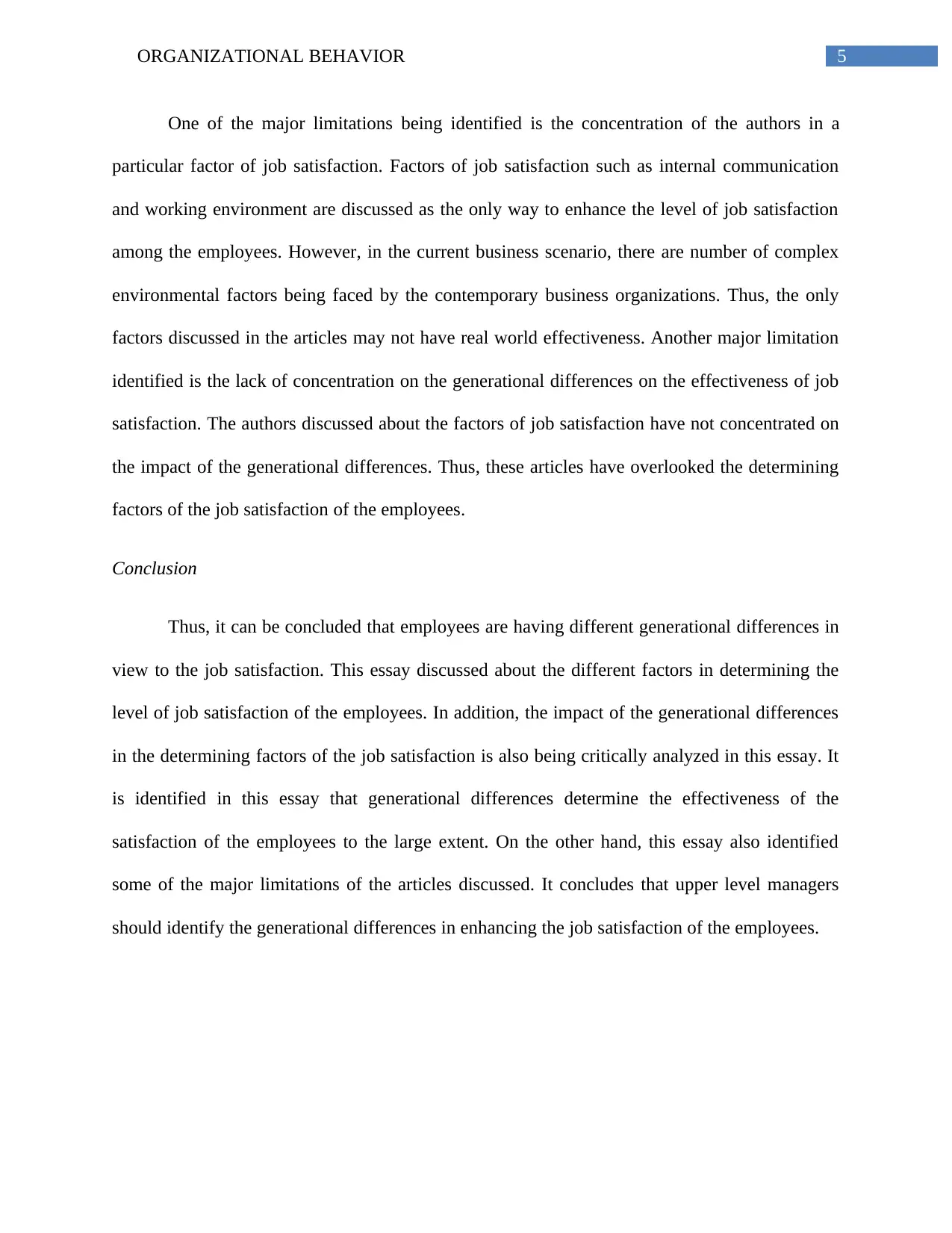
5ORGANIZATIONAL BEHAVIOR
One of the major limitations being identified is the concentration of the authors in a
particular factor of job satisfaction. Factors of job satisfaction such as internal communication
and working environment are discussed as the only way to enhance the level of job satisfaction
among the employees. However, in the current business scenario, there are number of complex
environmental factors being faced by the contemporary business organizations. Thus, the only
factors discussed in the articles may not have real world effectiveness. Another major limitation
identified is the lack of concentration on the generational differences on the effectiveness of job
satisfaction. The authors discussed about the factors of job satisfaction have not concentrated on
the impact of the generational differences. Thus, these articles have overlooked the determining
factors of the job satisfaction of the employees.
Conclusion
Thus, it can be concluded that employees are having different generational differences in
view to the job satisfaction. This essay discussed about the different factors in determining the
level of job satisfaction of the employees. In addition, the impact of the generational differences
in the determining factors of the job satisfaction is also being critically analyzed in this essay. It
is identified in this essay that generational differences determine the effectiveness of the
satisfaction of the employees to the large extent. On the other hand, this essay also identified
some of the major limitations of the articles discussed. It concludes that upper level managers
should identify the generational differences in enhancing the job satisfaction of the employees.
One of the major limitations being identified is the concentration of the authors in a
particular factor of job satisfaction. Factors of job satisfaction such as internal communication
and working environment are discussed as the only way to enhance the level of job satisfaction
among the employees. However, in the current business scenario, there are number of complex
environmental factors being faced by the contemporary business organizations. Thus, the only
factors discussed in the articles may not have real world effectiveness. Another major limitation
identified is the lack of concentration on the generational differences on the effectiveness of job
satisfaction. The authors discussed about the factors of job satisfaction have not concentrated on
the impact of the generational differences. Thus, these articles have overlooked the determining
factors of the job satisfaction of the employees.
Conclusion
Thus, it can be concluded that employees are having different generational differences in
view to the job satisfaction. This essay discussed about the different factors in determining the
level of job satisfaction of the employees. In addition, the impact of the generational differences
in the determining factors of the job satisfaction is also being critically analyzed in this essay. It
is identified in this essay that generational differences determine the effectiveness of the
satisfaction of the employees to the large extent. On the other hand, this essay also identified
some of the major limitations of the articles discussed. It concludes that upper level managers
should identify the generational differences in enhancing the job satisfaction of the employees.
⊘ This is a preview!⊘
Do you want full access?
Subscribe today to unlock all pages.

Trusted by 1+ million students worldwide
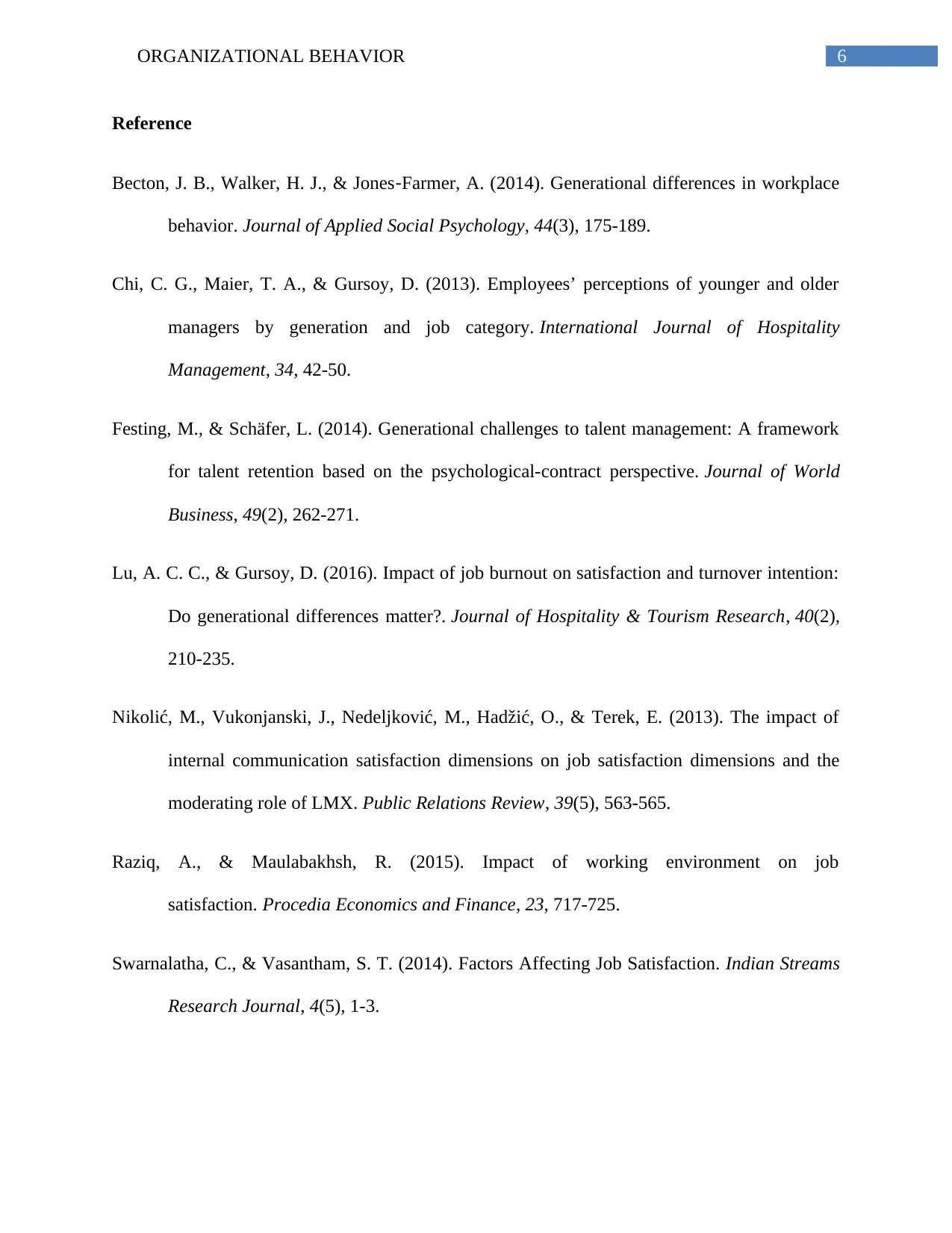
6ORGANIZATIONAL BEHAVIOR
Reference
Becton, J. B., Walker, H. J., & Jones‐Farmer, A. (2014). Generational differences in workplace
behavior. Journal of Applied Social Psychology, 44(3), 175-189.
Chi, C. G., Maier, T. A., & Gursoy, D. (2013). Employees’ perceptions of younger and older
managers by generation and job category. International Journal of Hospitality
Management, 34, 42-50.
Festing, M., & Schäfer, L. (2014). Generational challenges to talent management: A framework
for talent retention based on the psychological-contract perspective. Journal of World
Business, 49(2), 262-271.
Lu, A. C. C., & Gursoy, D. (2016). Impact of job burnout on satisfaction and turnover intention:
Do generational differences matter?. Journal of Hospitality & Tourism Research, 40(2),
210-235.
Nikolić, M., Vukonjanski, J., Nedeljković, M., Hadžić, O., & Terek, E. (2013). The impact of
internal communication satisfaction dimensions on job satisfaction dimensions and the
moderating role of LMX. Public Relations Review, 39(5), 563-565.
Raziq, A., & Maulabakhsh, R. (2015). Impact of working environment on job
satisfaction. Procedia Economics and Finance, 23, 717-725.
Swarnalatha, C., & Vasantham, S. T. (2014). Factors Affecting Job Satisfaction. Indian Streams
Research Journal, 4(5), 1-3.
Reference
Becton, J. B., Walker, H. J., & Jones‐Farmer, A. (2014). Generational differences in workplace
behavior. Journal of Applied Social Psychology, 44(3), 175-189.
Chi, C. G., Maier, T. A., & Gursoy, D. (2013). Employees’ perceptions of younger and older
managers by generation and job category. International Journal of Hospitality
Management, 34, 42-50.
Festing, M., & Schäfer, L. (2014). Generational challenges to talent management: A framework
for talent retention based on the psychological-contract perspective. Journal of World
Business, 49(2), 262-271.
Lu, A. C. C., & Gursoy, D. (2016). Impact of job burnout on satisfaction and turnover intention:
Do generational differences matter?. Journal of Hospitality & Tourism Research, 40(2),
210-235.
Nikolić, M., Vukonjanski, J., Nedeljković, M., Hadžić, O., & Terek, E. (2013). The impact of
internal communication satisfaction dimensions on job satisfaction dimensions and the
moderating role of LMX. Public Relations Review, 39(5), 563-565.
Raziq, A., & Maulabakhsh, R. (2015). Impact of working environment on job
satisfaction. Procedia Economics and Finance, 23, 717-725.
Swarnalatha, C., & Vasantham, S. T. (2014). Factors Affecting Job Satisfaction. Indian Streams
Research Journal, 4(5), 1-3.
1 out of 7
Related Documents
Your All-in-One AI-Powered Toolkit for Academic Success.
+13062052269
info@desklib.com
Available 24*7 on WhatsApp / Email
![[object Object]](/_next/static/media/star-bottom.7253800d.svg)
Unlock your academic potential
Copyright © 2020–2025 A2Z Services. All Rights Reserved. Developed and managed by ZUCOL.





